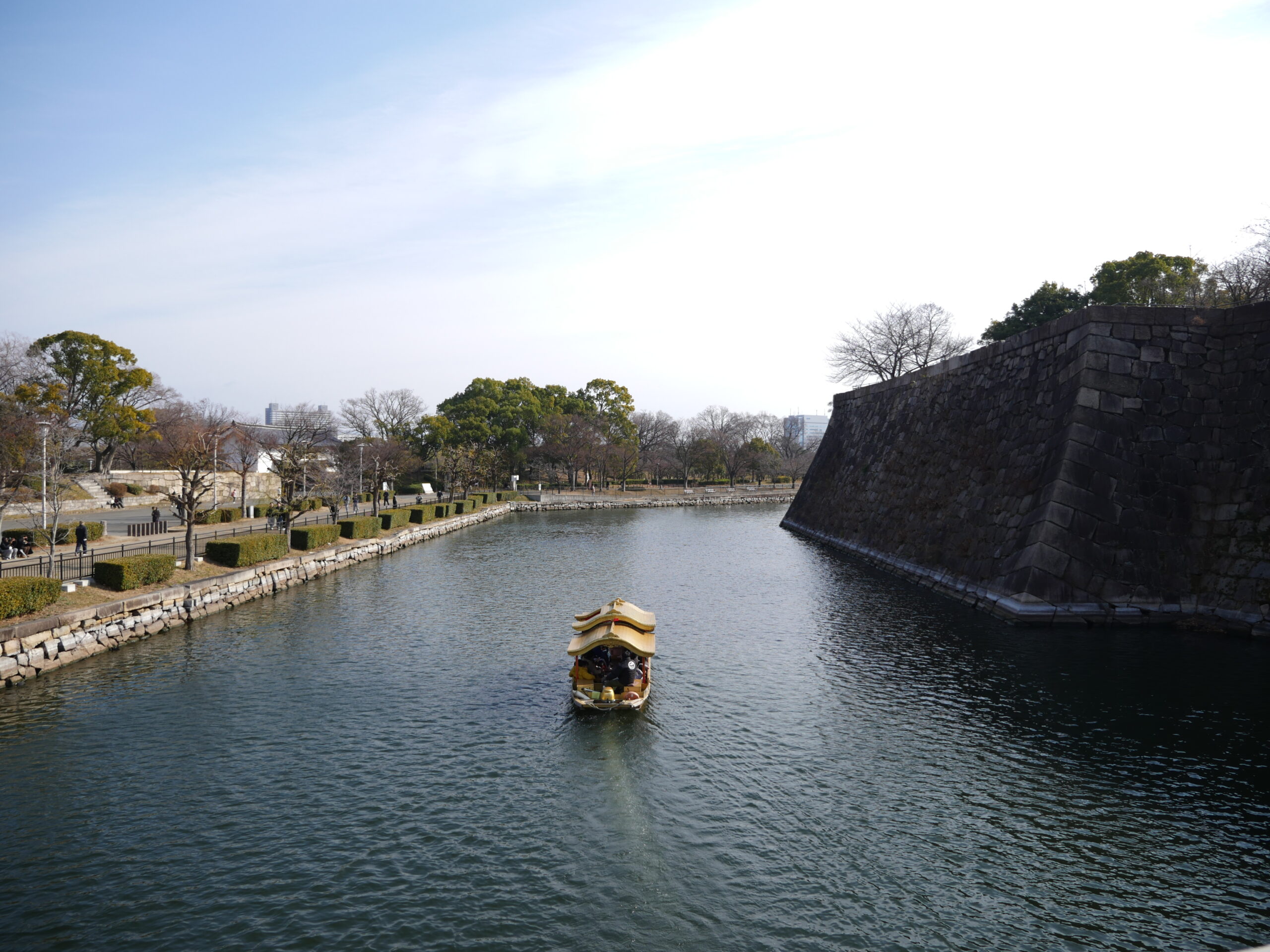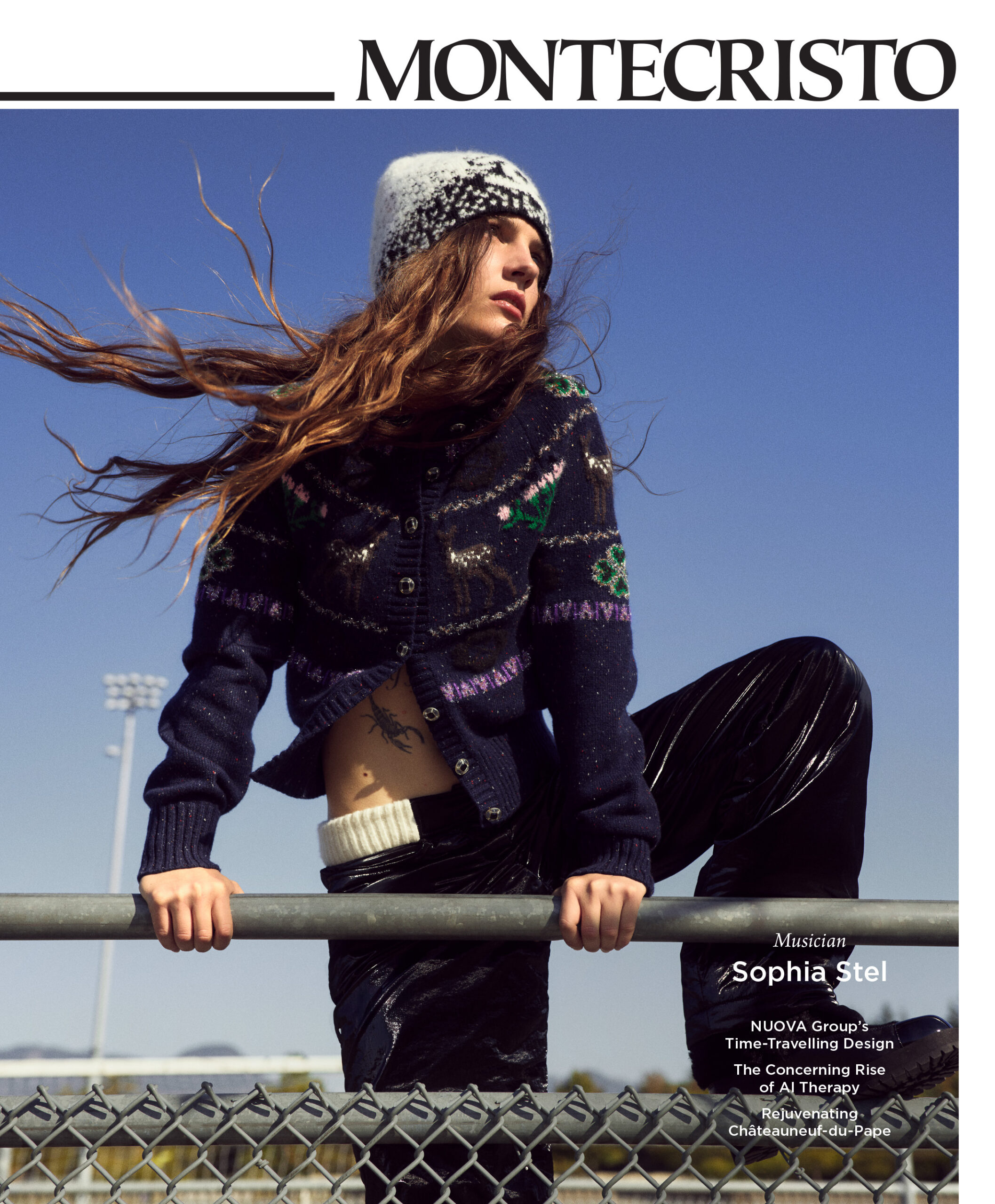On a trip to Osaka, Japan, I came face to face with a five-eyed , blue-and-red, bipedal cryptid. Both unnerving and inviting, it resembled a mutating Cookie Monster. This was Myaku-Myaku, Osaka’s Expo 2025 mascot. A friendly collection of cells and water, Myaku-Myaku is a quirky yet fitting ambassador for its hometown. During the Meiji period (1868–1912), Osaka was called the City of Water. Everywhere I went, I witnessed how water has shaped this ancient and vibrant metropolis.
At the Osaka Museum of History, I investigated the city’s watery origins. Osaka was founded where the Yodo River meets the Seto Inland Sea. Until 3000 BC , much of the area was submerged. The museum sits on the Uemachi Plateau, rising above the ancient ocean. Archaeological evidence of human occupation on this promontory dates back to 7000 BC. As the waters receded, more settlements sprang up and this fertile region became a centre of rice production . In 683 AD, these settlements became the ancient port city of Naniwa—once Japan’s capital. And in the 16th century, it was renamed Osaka.
Immersive exhibits depicting Osaka’s development begin on the 10th floor, offering incredible vantages of the city’s unending skyline. That skyline includes Osaka Castle, built in 1583 by Toyotomi Hideyoshi. It looks dainty from up here despite impenetrable stone walls rising out of wide moats.
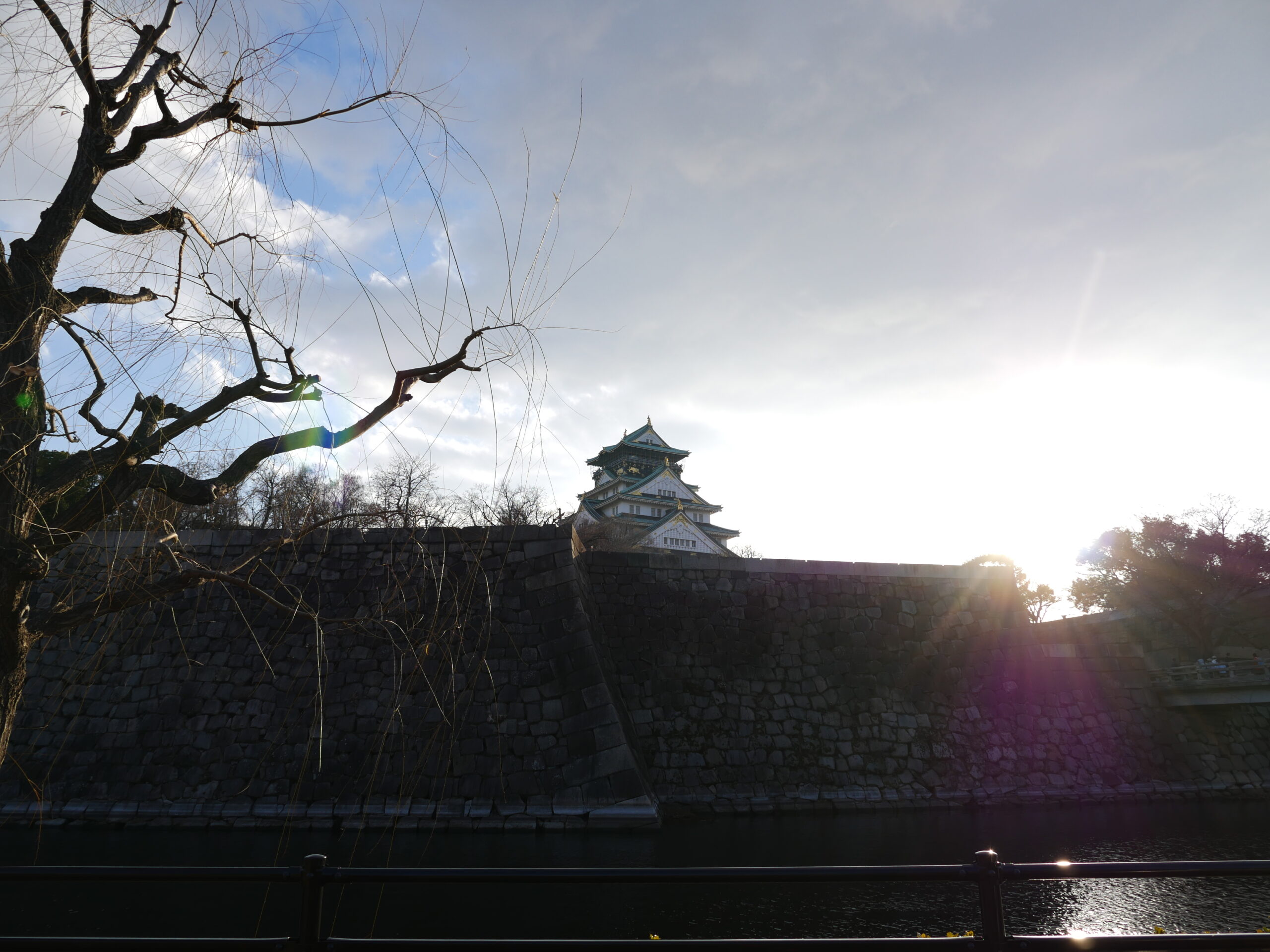
Osaka Castle.
The castle fell in 1615, after shogun Tokugawa Ieyasu laid siege to Osaka. He aimed to crush the Toyotomi clan, who opposed his rule. The final battle ended when Toyotomi’s second wife Yodo-dono and their son Hideyori performed seppuku, or ritual suicide, as the castle burned. This violent scene is memorialized in stone in the castle’s keep.
My experience here instead reflected the 250 years of peace that followed. A golden pleasure boat now glides around the castle’s inner moat. Along this waterway, I passed a gorgeous plum grove (planted in 1974), Hōkoku Shrine (built in 1879), and of course, an incognito Lawson convenience store, ubiquitous across Japan. I loved Osaka Castle’s grounds so much that I returned to walk them a second time.
Less than 100 years after its fall, Osaka Castle was rebuilt and burnt down twice—in one case due to lightning . But Osaka’s economic power was only growing. The Dōjima Rice Exchange, now recognized as the world’s first futures exchange, was established in 1697. It was located on Nakanoshima, a narrow island between the Dōjima River and Tosabori River. This urban sandbar, once a bustling centre of commerce, is now a serene refuge for art and architecture.
Before I explored the island, I stopped at Moto Coffee and sat on the terrace overlooking the eastern end of Nakanoshima. My view included Osaka City Central Public Hall (Osaka-shi Chuo Kokaido). This red-brick, bronze-domed, Renaissance revival building was completed in 1918. Gazing at the hall’s shimmering reflection in the Tosabori River, I sipped an exceptional latte from a handmade cup. I considered that good coffee must be made with good water—even if it is drowned in steamed milk. Then I walked across the historic Naniwa Bridge.
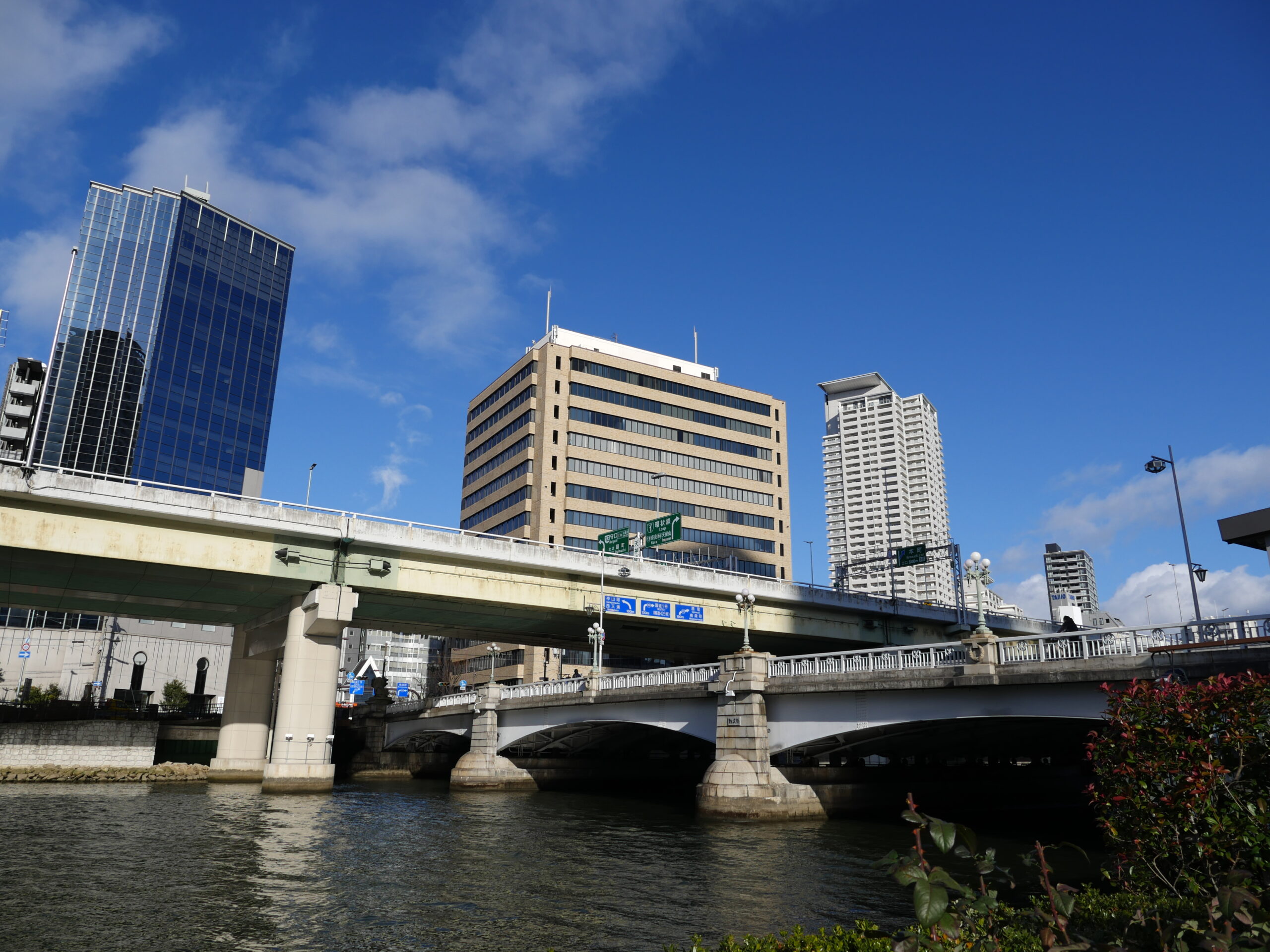
Dōjima River and the Naniwa Bridge.
Despite a wealth of museums, I opted to tour Nakanoshima’s parks and architecture. I began in the elegant Nakanoshima Rose Garden, framed by parallel rivers and forests of skyscrapers looming beyond. As I walked toward the garden’s entrance, I saw walls of smooth, exposed concrete arcing toward the Dōjima River. This was Nakanoshima Children’s Book Forest, a free library for children. World-renowned Osaka-born architect Tadao Ando designed the facility as a gift to his hometown in 2020.
It is a beautiful example of Ando’s architectural style. Where this minimalist, concrete structure bends toward the water, its solid walls give way to glass. Inside, wooden shelves line a three-storey atrium, with winding staircases that double as seating. But the space is warm and playful rather than brutalist. Ando even placed a giant green apple outside. Kids ran laps around this enormous fruit while their parents waited in line.
This is not the only comically large foodstuff Ando designed for Nakanoshima. Walking westward, I crossed the Nakanoshima Garden Bridge to find the Dōjima Rice Exchange memorial. Under an overpass, I found Ando’s stone monument marking this historic site. It is a huge, solitary grain of rice—both tasteful and amusing.
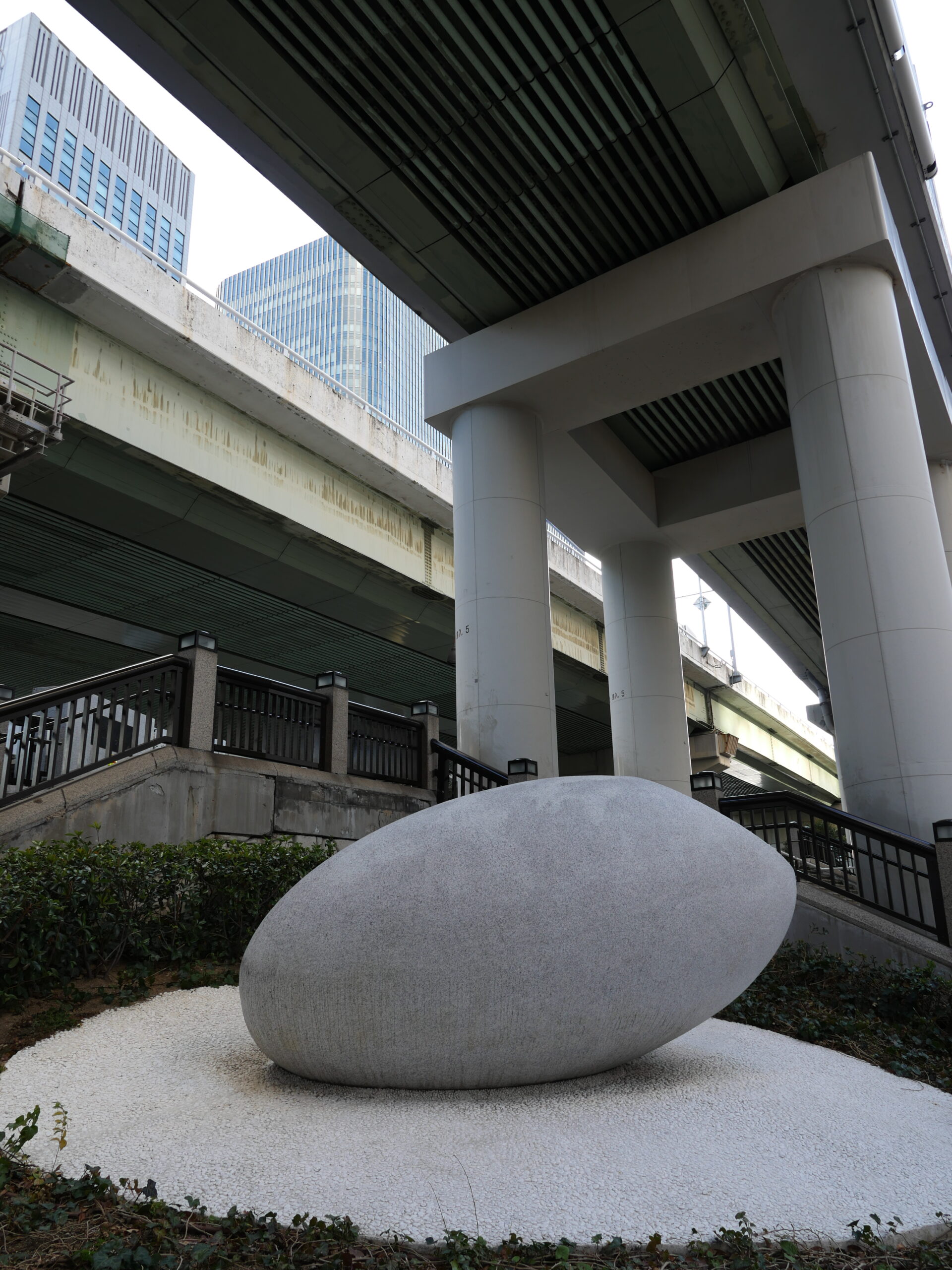
The Dōjima Rice Exchange memorial.
Nakanoshima is quiet compared to Osaka’s other downtown waterside destination. Dōtonbori Canal glows, reflecting the lighted billboards adorning surrounding buildings. Crowds ripple past innumerable storefronts, bars, and food vendors. While I enjoyed the gleaming spectacle of Asahi, Glico, and Megmilk Snow Brand ads turning night into day with their bright lights, I soon shrank from the masses.
Turning down a darkened path, I left LEDs and asphalt for lanterns and stone pavers. I arrived in Hozenji Yokocho, an Edo-period street in the middle of modern Osaka. Rounding a corner, the quaint street suddenly turns into a temple. Built in 1637, Hozenji Temple was mostly destroyed by Second World War bombing raids. However, one statue survived—the Buddhist guardian Fudo Myo-o .
Mizukake Fudo, as he is known by locals, is covered in moss. Thousands of visitors have contributed to his fuzzy green appearance by tossing water on the statue for good luck. This is a local tradition, so check before chucking fluid on any other statue in Japan. Instead, you can use the water provided at Shinto and Buddhist shrines to cleanse your hands before prayer.
Moving through two more side streets, I sought another way to purify my spirit. I found it next to a small sign written in English and kanji: Bar 昭和 (Showa). Named for the Shōwa period (1926–1989), it is a tiny space packed with whisky and charm. Although there was no menu, I knew what I wanted when I spotted the other guests’ drinks. I asked the friendly owner what whisky he recommended for my own cocktail. He gestured to a square bottle bearing a yellow label. I accepted. Then he handed me a slender glass, fizzing with golden liquid over clear ice.
Launched in 1937 as Suntory Whisky, this popular blend is now known as Kakubin (square bottle). The company’s breakthrough product owes its origins to this city. Suntory’s founder and first master blender, Shinjirō Torii, was born to a rice merchant in Osaka’s Chuo Ward. Torii’s blending talents later earned him the nickname “the nose of Osaka.” Suntory spread the “Kaku High” throughout Japan in the 1950s, and its popularity endures. I enjoyed my Suntory Whisky highball. It tasted of caramel apples and was gone too soon. I clung to my empty glass, reluctant to leave Bar Showa.
Despite eventually leaving the bar, I was able to stay in the Showa era in spirit. I travelled to the Expo ʹ70 Commemorative Park on the most midcentury form of transportation available: the monorail. The park is land locked, although it contains an artificial lake called Yume-no-Ike (Dream Pond). Expo 2025, in contrast, will take place on a manufactured island called Yumeshima (Dream Island). This link between the two expos may be a bit forced, but the connection to water persists.
Expo ʹ70’s centrepiece was the 70-metre-tall Tower of the Sun (Taiyō no Tō). Designed by avant-garde Japanese artist Tarō Okamoto, it is a striking, vaguely humanoid structure that stands for Osaka’s past, present, and future—represented by the three suns on its exterior. The tower reopened to the public in 2018, after being closed for almost half a century.
Entering the tower was the strangest and best experience I had in Osaka. Inside is a trippy art installation called the Tree of Life (Seimei no Ki). This blood-red, cavernous space pulsates with light and echoes with eerie vocals from the “Hymn to Life” by composer Toshiro Mayuzumi . As I climbed the stairs up from the ground floor’s primordial soup, I saw all organisms odd and wild—including polyps, dinosaurs, and gorillas—though no humans. The evolutionary tree stops with Neanderthals. Okamoto wanted us to look beyond ourselves and strive for something greater.
The new expo mascot might not be the enlightened being Okamoto envisioned. But Myaku-Myaku can certainly trace its ancestral roots back to Okamoto’s surreal style. And this weird-and-wet figure is the perfect representative for its hometown’s lively and watery past, present, and future.

